Friedrich Engels believed that labor created humans, but modern scientists argue that love, children's curiosity, and long-distance running played a much more significant role in the formation and development of our species. In his lecture series for Qalam, paleontologist Alexander Markov explains how and why Homo sapiens emerged.
From an anatomical perspective, the most remarkable feature of hominid evolution is the extraordinarily rapid increase in brain size, both in absolute terms (measured in cubic centimeters (cm³)) and relative terms (as a percentage of body size), which occurred over the last two million years in the Homo genus (humans). During this time, the brain size of our ancestors tripled from about 400–500 cm³ in the direct ancestors of the Homo genus (the australopithecines) to 1300–1500 cm³ in the later members of Homo, including Neanderthals and Homo sapiens. The average rate of brain growth over the past two million years of human history was approximately 11 cubic millimeters (mm³) per generation (about a quarter of the volume of a drop of water). It seems slow, but in evolutionary terms, it's astonishingly fast. While a general trend of gradual brain enlargement can be observed in many groups of mammals, the rapid growth seen in humans is unparalleled. This isn't just an observation based on mere visual assessment but a conclusion based on rigorous quantitative analysis. The hyper-fast brain expansion in the evolution of the Homo genus is a unique, one-of-a-kind evolutionary process.
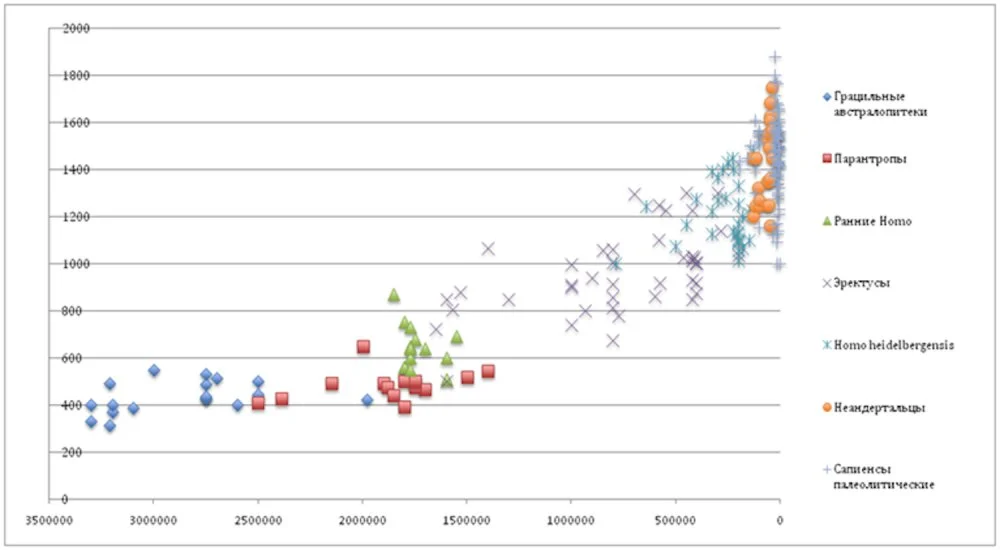
Graph of brain volume growth from Australopithecines to Homo Sapiens/Provided by Alexander Markov
The first hominids whose brains grew larger than those of chimpanzees and other great apes are traditionally classified as Homo habilis (meaning ‘handy man’). All fossil remains of this species have been found in Africa and date back to about 2.3 to 1.5 million years. Homo habilis likely evolved from australopithecines.
Compared to australopithecines, the brain of Homo habilis shows increased development in areas associated with speech and hand movement coordination in modern humans. Thus, Homo habilis is the first hominid to show signs of evolutionary progress toward the development of speech.
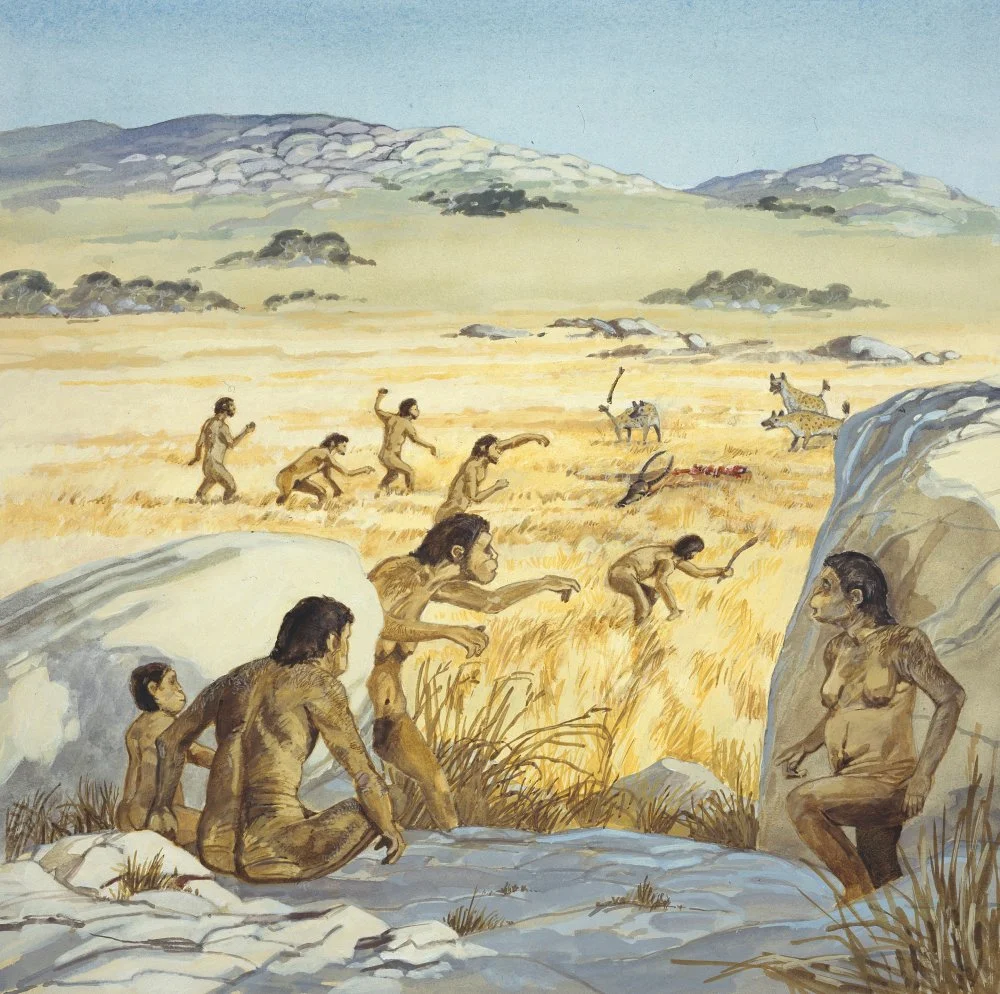
Homo habilis in action/Alamy
Everything that happened in hominid evolution before brain enlargement began—reduction of canines, improvement of bipedal locomotion, changes in the feet, presumed changes in social life—can be viewed as purely ‘monkey business’. If some of these hominids had survived unchanged to the present day, they would now be sitting in a zoo. They would walk on two legs around their enclosure, form monogamous families, chew fruits and steaks. And even their small, almost human-like canines would not evoke a sense of kinship with these ‘animals’ for the public. The ticket to the world of humans is intelligence, and intelligence requires brains.
WHY A BIG BRAIN IS REQUIRED
There are as many hypotheses about why the brains of Homo habilis began to grow as there are about the origins of bipedalism. We will return to this topic, but one key point must be mentioned right away.
Despite all the caveats, exceptions, and deviations from the general rule, brain growth still implies an increase in intelligence. Based on what is currently known about brain function, it can be concluded that simply increasing the number of neurons in the cortex—even without any particular restructuring or reorganization—can automatically lead to an increase in intelligence, meaning the ability to solve more complex problems. Memory is ‘recorded’ in the contacts between neurons (synapses). More neurons mean more potential for forming such contacts, which means more memory capacity.
more information in the brain leads to better decision-making abilities.
Although this reasoning does not constitute strict scientific proof, it is unlikely that the increase in brain size in Homo species had any adaptive significance other than the development of cognitive (mental, intellectual) abilities.
A positive correlation between brain size and intelligence can undoubtedly be drawn, and while it is not absolute (the correlation coefficient is less than one), this does not imply that ‘size does not matter’. Such correlations are never absolutely rigid. The correlation coefficient is always less than one, regardless of the dependency we examine: between muscle mass and strength, leg length and walking speed, and so on.
Indeed, there are very intelligent people with small brains and less intelligent people with large brains. Anatole France, for instance, had a brain volume of only 1017 cm³—a normal volume for late Pithecanthropus (Homo erectus) and much below average for Homo sapiens. However, this does not contradict the fact that intense selection for intelligence contributes to an increase in brain size. For such an effect, it is sufficient that an increase in brain size slightly raises the likelihood of an individual being more intelligent—and the possibility is indeed increased. A close examination of the brain sizes of great individuals, often cited to refute the link between intelligence and brain size, reveals that the overwhelming majority of geniuses do have larger-than-average brains. Anatole France and a few other well-known individuals with small brains appear as ordinary statistical outliers in this context, exceptions that any biological regularity will demonstrate.
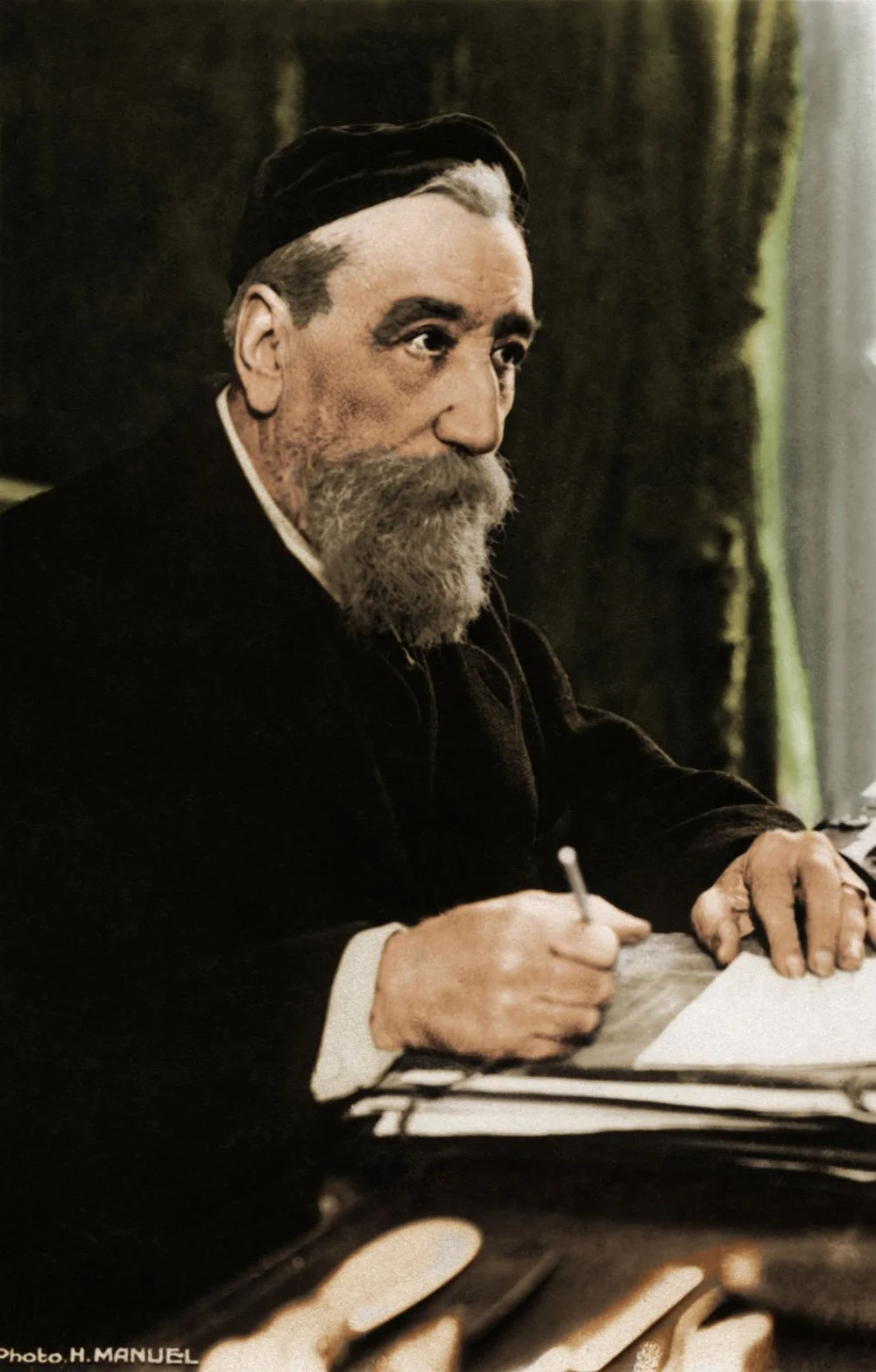
Anatole France. French writer, 1844-1924/Culture Club/Getty Images
The main conclusion from this is that the rapid increase in brain size in human evolution was likely driven by very strong selection for mental abilities.
A LARGE BRAIN IS AN EXPENSIVE LUXURY
The brain is an "expensive" organ in the sense that its enlargement brings a number of difficult challenges. A large brain consumes an excessive amount of calories, especially in young children (relative to their total energy expenditure). This is because neurons constantly, even in a resting state, expend energy pumping ions across membranes. They must maintain the transmembrane potential (the unequal concentration of positively and negatively charged ions inside and outside the neuron). This situation is like a tense silence, where it seems like nothing is happening, but everyone knows how much effort and energy it takes to maintain it. Similarly, the energy consumption of neurons doesn’t significantly decrease when we are idle or not actively thinking. Therefore, under equal conditions, a large-brained primate requires more food. From an evolutionary standpoint, this is a serious disadvantage of having a large brain.
In adults, the brain makes up about 2% of body mass but consumes around 20% of all calories.
Another drawback is the increased load on the cervical spine—it’s harder to carry a heavy head on the shoulders. This requires corresponding adjustments to the skeleton, posture, and the skull itself, particularly reducing large protruding jaws. But how, then, can tough food be chewed?
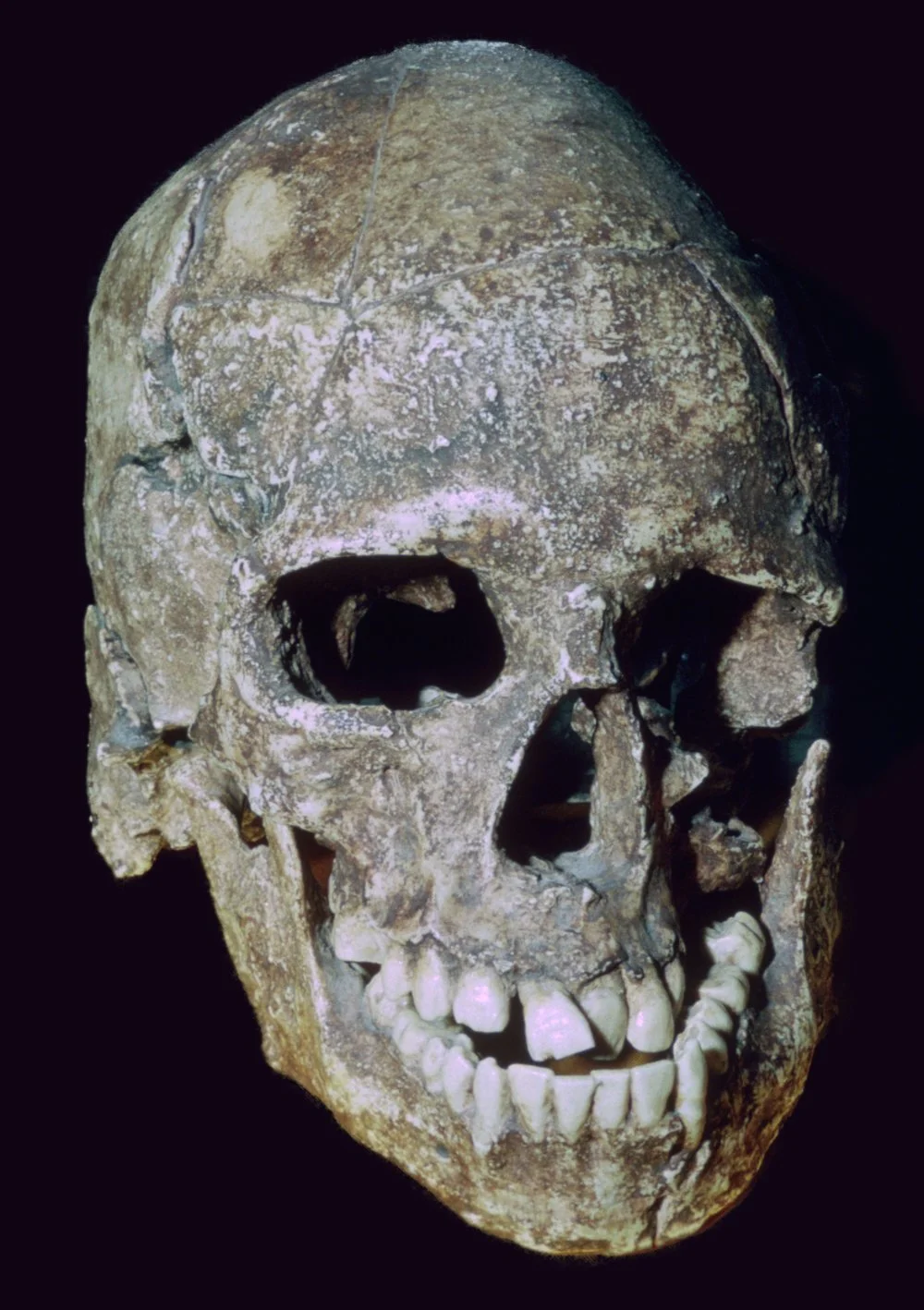
Paleolithic Skull of 'Grimaldi man' (replica). Discovered in Baoussé Rossé one the Cote de Azure/Photo by CM Dixon/Print Collector/Getty Images
The third issue (perhaps even the primary one) is that a large head creates significant problems during childbirth. It’s difficult to give birth to large-headed offspring. This problem is worsened by bipedalism: changes to the pelvis that might ease the birth of large-headed children conflict with the demands of bipedal locomotion. If brain growth had occurred in quadrupedal apes, like gorillas and chimpanzees, it would have been easier to solve this issue. But as it happened, a large brain "became necessary" precisely for bipedal, not quadrupedal, apes. For efficient bipedal walking, the pelvis must be narrow. As a compensating adaptation, hominid offspring began to be born at earlier stages of brain development compared to other great apes. This allowed for most brain growth to occur in the years following birth.
A PROLONGED CHILDHOOD
Evolution is an endless search for compromises, and nothing comes for free. The birth of offspring with underdeveloped brains led to a chain of consequences, including the extension of childhood and an increased burden on parents. Human offspring are far more helpless and require significantly more care than chimpanzee or gorilla infants. This, in turn, likely promoted the selection for stronger maternal attachment and love for children. The survival of offspring became even more dependent on paternal care (the father's contribution to offspring). As a result, selection for the ability of fathers to feel strong emotional attachment to their families must have intensified. Additionally, selection would have favored females who could stimulate the development of such attachment in their partners. Thus, brain enlargement likely contributed to the evolution of love.

Berthe Morisot (1841–1895). The cradle. 1873/Wikimedia commons
To understand anthropogenesis, it’s essential to know not only how the brain volume of adults changed but also how the course of its individual development evolved. The speed at which the brain grew at various stages determined the "metabolic cost" of raising children, that is, the amount of resources that adults (primarily mothers) had to invest in their offspring. A rapidly growing brain requires enhanced nutrition. Moreover, it is highly plastic: brain growth in children is accompanied by large-scale rewiring of neural connections and extremely rapid learning. A growing brain consumes not only calories but also a tremendous amount of information. It is believed that for the development of intelligence, both the size of the adult brain and a sufficiently long period of postnatal brain development are important.
Unfortunately, paleoanthropological evidence that could provide insights into the dynamics of brain growth in our distant ancestors is quite scarce. Only three well-preserved skulls of australopithecine children are known. Child skulls of habilines, unfortunately, are unknown. There is only one child skull of Homo erectus ("the Mojokerto child" from the island of Java), followed by another gap. The situation with Neanderthals is slightly better. The problem is compounded by numerous additional uncertainties: imprecise dating, difficulties in determining individual age from fossilized bones, and potential errors in measuring the volume of endocasts (the relief on the inner surface of the skull, reflecting the pattern of large brain grooves, folds, and blood vessels).

Skull of the «Mojokerto Child»/Google arts and culture
As of today, we can state the following: Modern humans already significantly surpass chimpanzees in brain size at birth. As development progresses, these differences become much more pronounced, not only due to the extended brain growth period in humans but also due to a faster growth rate. It is generally thought that brain volume growth in modern humans stops at around age eight, while structural changes and the maturation of various areas of the cerebral cortex (neocortex) continue until 20-25 years. However, brain growth slows gradually, making it difficult to pinpoint exactly when it ceases.
The available data on australopithecines fits entirely within the range of variability seen in modern chimpanzees. In other words, australopithecines show almost no difference from chimpanzees in terms of brain size or the growth dynamics in their offspring. Apparently, such dynamics are close to the original ancestral state of hominids.
When interpreting data on the Mojokerto child, much depends on the estimation of his age. Some experts have suggested that the skull's owner was about two years old or even older at the time of death. Other specialists believe these estimates are inflated and propose an age of one year. In that case, the Mojokerto skull, though barely, still falls within the normal range of variability for H. sapiens, especially among boys, who show greater variability in brain size than girls. Among modern one-year-old boys, some individuals are found to have brains as small as that of the Mojokerto child.
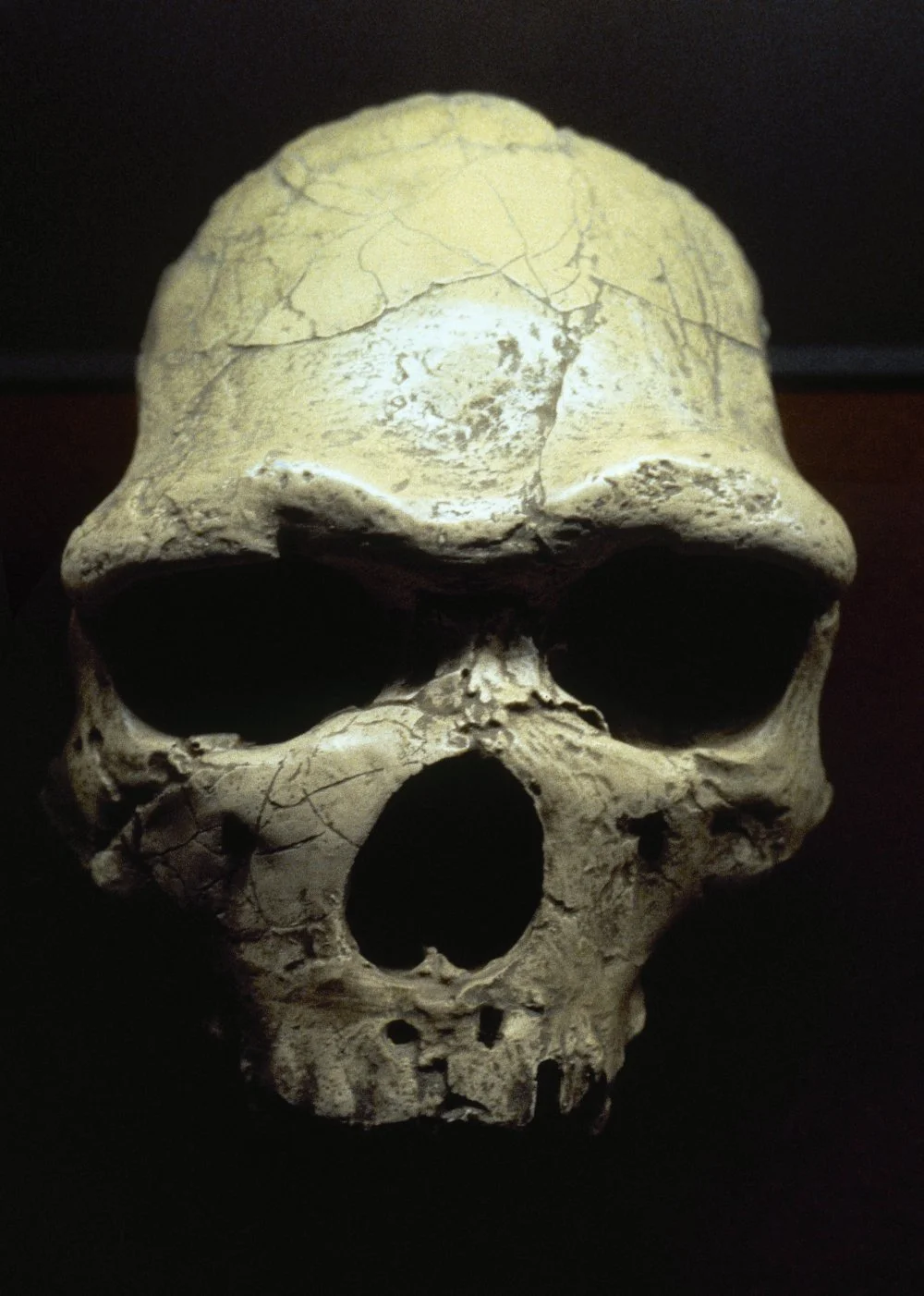
Java Man or Pithecanthropus erectus (Homo Erectus erectus) fossils discovered on island Java (Indonesia)/Alamy
The brain size of newborns can be inferred from the proportions of the female pelvis (if no data on the newborns themselves are available). Judging by this indirect sign, newborn Homo erectus likely had skulls of approximately the same size as newborn Homo sapiens. Therefore, during early childhood (in the first year of life), the brain of H. erectus grew at a similar rate to that of H. sapiens—that is, very quickly, much faster than that of chimpanzees and australopithecines.
On the other hand, the average brain size of adult Homo erectus was smaller than that of Homo sapiens. This means that after the first year, the brains of Homo erectus infants must have grown either more slowly than ours or for a shorter period (a shortened childhood). It follows that Homo erectus women had to invest a lot of energy into raising a child during the first year of life (about as much as later Homo species), but in the following years, the "metabolic cost" of offspring likely decreased. Either childhood was shortened, or brain growth in childhood (after the first year) was very slow; in either case, Homo erectus mothers would have expended less energy raising their children. It is possible that the limited brain growth in Homo erectus after the first year of life imposed constraints on their intellectual development.

An increase in cerebral blood flow over time (on the x-axis, time in millions of years ago; on the y-axis, cerebral blood flow in cubic centimeters per second).
As for Neanderthals, we can say with even greater certainty that they were born with brains approximately the same size as Homo sapiens. In the first 3–4 years of life, the brain growth dynamics of Neanderthals and Homo sapiens were almost identical. The brains of adult Neanderthals were, on average, larger than those of modern humans, and this difference was formed due to faster brain growth in Neanderthals during "late childhood," roughly from 4 to 7 years of age.
Apparently, the rate of brain growth at different stages of postnatal development changed very unevenly during the evolution of the Homo genus. First, the head size of newborns increased, and brain growth accelerated sharply in the first year after birth. In the next stage (in later Homo species), "early" brain growth remained about the same as in Homo erectus, but "late" brain growth accelerated. Perhaps it was this second change that played a key role in increasing the cognitive potential of humans and, ultimately, provided the foundation for accelerating cultural evolution? After all, the most complex and important cultural information, the accumulation of which eventually made humans the masters of the planet, is transmitted to young individuals, not in the first year of life, and not even in the second or third, but later. The extension of postnatal brain growth, presumably linked to a more extended learning period, may have developed as an adaptation to living in a society with an ever-increasing volume of cultural information necessary for survival.
Why Did Such an Expensive Organ Increase So Rapidly in Our Ancestors?
Let’s return to the question of why the brain increased so quickly in the evolution of Homo. If we observe that, over the course of two million years, a costly organ like the brain consistently grew larger along a particular evolutionary line, this implies that there was strong selective pressure in favor of individuals with larger brains throughout that period.
This is important to grasp, so let’s repeat it in different words. People with larger brains had a selective advantage. On average, they left more offspring who survived to maturity and more effectively passed their genes on to subsequent generations than those with smaller brains. And this continued for a long time—two million years. Imagine this picture! Early Homo with a brain size of 700 cm³ left, on average, more children, grandchildren, and great-grandchildren than their relatives with a brain size of 690 cm³. Homo erectus with a brain of 1030 cm³ reproduced more successfully than those with a brain of 1020 cm³. Homo heidelbergensis, with a brain size of 1190 cm³, had more descendants, meaning they more effectively spread their genes than those with a brain size of 1180 cm³. All of this happened despite the fact that at every evolutionary stage, "brainier" individuals (all other factors being equal—an important caveat!) had a harder time finding food and producing offspring than their competitors with smaller brains.
Such a prolonged, sustained evolutionary process cannot be explained by climate change, lifestyle shifts, or any single event.
However, at certain stages, specific events may have occurred that facilitated further brain growth, such as the transition to eating food cooked over fire, which alleviated energy limitations on brain growth and mitigated the negative consequences of reducing teeth and jaws.
Such long-term, directed processes often operate in a self-sustaining mode. They are driven by positive feedback loops. This was likely the case with brain growth as well. In other words, brain enlargement in our ancestors must have somehow contributed—not directly, but indirectly—to further brain enlargement. The process had to be self-sustaining.
Evolutionary theorists are aware of this phenomenon. Several possible positive feedback loops that could have "spun up" the self-sustaining development of the brain and cognitive abilities in the genus Homo are discussed in scientific literature.

Caveman Playing the Flute. Artist: Kuznetsov, Konstantin Pavlovich (1863-1936)/Getty Images
Firstly, there is sexual selection for intelligence, driven by the so-called "Fisherian runaway." This term refers to an evolutionary process that can create cumbersome traits that seem unnecessary or even harmful for survival—such as the large and bright "tail" (actually the train) of the peacock. For example, if females, for whatever reason, start to prefer males with colorful (and most likely unhelpful for the male) adornments, those males will leave more offspring. Thus, a seemingly useless trait becomes evolutionarily advantageous (since it increases the efficiency of passing on genes to the next generations). This creates a positive feedback loop: female preferences turn a previously neutral or harmful trait into a useful one, which in turn makes the preferences themselves advantageous because females who choose attractive males will have attractive sons and, ultimately, leave more grandchildren. As a result, both the "genes for ornaments" and the "genes for a preference for ornamented males" spread harmoniously within the population. Some scientists suggest that at some point, cognitive abilities became a sexually attractive trait in our ancestors, similar to such "peacock-like" decorations. This could have led to the spread of both "intelligence genes" and "genes for preferring intelligent partners" within the population.
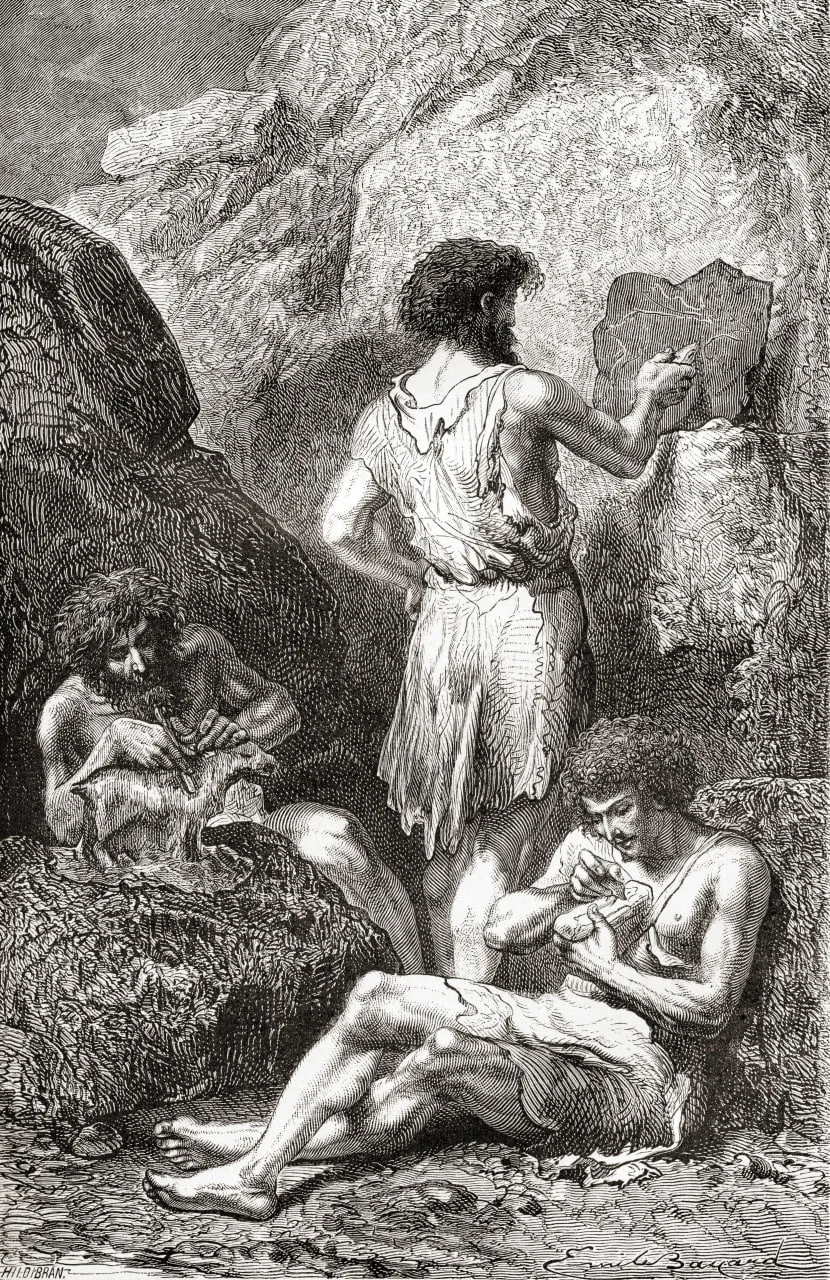
Neanderthals sculpting and drawing on the walls of their caves during prehistoric times/Universal History Archive/Universal Images Group via Getty Images
Secondly, there is the Machiavellian intelligence theory *(named after the great Italian thinker Niccolò Machiavelli (1469–1527), who is attributed with aphorisms like "The ends justify the means" and "People are always wicked unless necessity forces them to be good"). Most likely, reproductive success among our ancestors heavily depended on social status, as is usually the case with primates. However, increasing one's status through brute force (as many primates do) became difficult at some point—perhaps due to changes in social structure, which we discussed in the previous lecture. As a result, a more robust selection for sophisticated social intelligence allowed individuals to form beneficial alliances, make favorable impressions on others, skillfully deceive and manipulate them, and perform other "Machiavellian tricks."
If, as anthropologists suggest, levels of intragroup aggression decreased among ancient hominids, the role of brute force in status competition may have diminished while Machiavellian strategies increased. It's easy to imagine how, within the small, tightly-knit groups of our ancestors, an endless "evolutionary arms race" unfolded, ultimately leading to the development of an unprecedentedly powerful social intelligence.
British anthropologist Robin Dunbar discovered a positive correlation between brain size (specifically, the relative size of the neocortex—the cerebral cortex) and the size of social groups in primates. The more developed the cortex, the larger (on average) the groups primates can form. The reasons for the positive connection between group size and brain volume in primates are quite clear. Unlike most herd animals, primates recognize all their fellow group members individually and have specific relationships with each one.
Personal relationships are a very resource-intensive form of intellectual activity.
Predicting the reactions of a fellow group member is possibly the most complex computational task the primate brain faces. All other objects a primate interacts with and can influence are much simpler than fellow group members. Moreover, this task is like trying to catch your own tail.
Suppose you are smart enough to predict the actions of your group members, giving you a reproductive advantage. Your genes will spread quickly, and in a few dozen generations, everyone in the population will become slightly smarter on average. This means that their behavior can no longer be predicted using the old methods, and everything must be recalculated from scratch!

Pieter Brueghel the Elder: The Blind Leading the Blind. The parable of the blind. 1568. Capodimonte Museum, Naples, Italy/Wikimedia Commons
This task is not only the most complex but also the most important: the reproductive success of a primate depends more on its peers than on anything else. The higher an individual's "authority" in the group, the higher their position in society, and the better their chances of leaving numerous and viable offspring, all else being equal. This applies to both males and females in general.
DEMOCRACY DEVELOPS THE BRAIN
In a society with a strict hierarchy based on submission and despotism, the alpha male can monopolize access to all the females in the group. In this situation, subordinate males, forcibly excluded from reproduction, are motivated to learn how to "negotiate" with each other and form alliances to overthrow the tyrant. This is a risky endeavor and also requires significant mental effort from the conspirators. On the one hand, each is interested in maximizing the chances of success and, on the other, in minimizing personal risk by "using others to pull the chestnuts out of the fire." Thirdly, they must ensure that their fellow conspirators do not suspect they are being betrayed; they must also maintain their reputation within the group of plotters. Fourthly, they must secure a favorable "redistribution of power" in the event of success (ideally, they would replace the deposed tyrant themselves, pushing aside their fellow conspirators).

Cornelis van Haarlem. The Fall of the Titans. Statens Museum for Kunst/Wikimedia Commons
The tyrant, on the other hand, can use several different strategies to minimize the likelihood of rebellion. He may preemptively expel all young males from the group—this would result in small, scattered harem groups, as seen with gorillas. This works as long as there is no intense competition between groups and the pressure from predators is not too great. However, if external threats increase, weakening the group by expelling the young becomes disadvantageous. The leader can also act more subtly, for example, by enlisting the support of lower-ranking males—essentially "lackeys"—who, in exchange for the leader's favor, will readily help him keep mid-ranking males in line. This is similar to how Ivan the Terrible used the Oprichniks in his struggle against the boyars. This strategy is very typical for tyrants.

Nikolai Nevrev. Oprichniki. Kyrgyz National Museum of Fine Arts Gapara Aitieva/Wikimedia Commons
In an egalitarian society, primate success depends less on strength and more on intelligence than in a despotic one.
Not only males, but females too, can now gain a reproductive advantage through the ability to manipulate the behavior of their peers.
A clever female can form friendships with other females and secure the support of one or several high-ranking males. As a result, it will be much easier for her to raise offspring than for a less intelligent female, who cannot make a favorable impression on her peers or establish friendly, altruism-based relationships with them.
In an egalitarian society, a male cannot monopolize access to females simply by beating up his rivals. They will band together and quickly put the upstart in his place. He must resort to cunning. He has to find more sophisticated ways to attract more females while outmaneuvering his competitors—methods that must not only appeal to the opposite sex but also avoid causing too much resentment among rival males. Natural selection will favor those males who manage to mate with the greatest number of females while still appearing honest, noble, and virtuous gentlemen in the eyes of other males. This is no easy task and requires intelligence.
ON THE BENEFITS OF MARITAL INFIDELITY
If monogamy is the norm in a society, as is believed to have been the case with hominids (and not the relatively promiscuous mating system seen in chimpanzees), increasing one's reproductive success could become an even more intellectually demanding task. First, for both sexes, the challenge of choosing (as well as seducing and retaining) the best marital partner arises in full force. Family is a serious matter. Secondly, the stability of monogamous bonds among hominids has never been absolute. Marital infidelity has always existed, and adaptations for both preventing it and successfully and safely engaging in it likely evolved alongside the establishment of monogamous traditions.
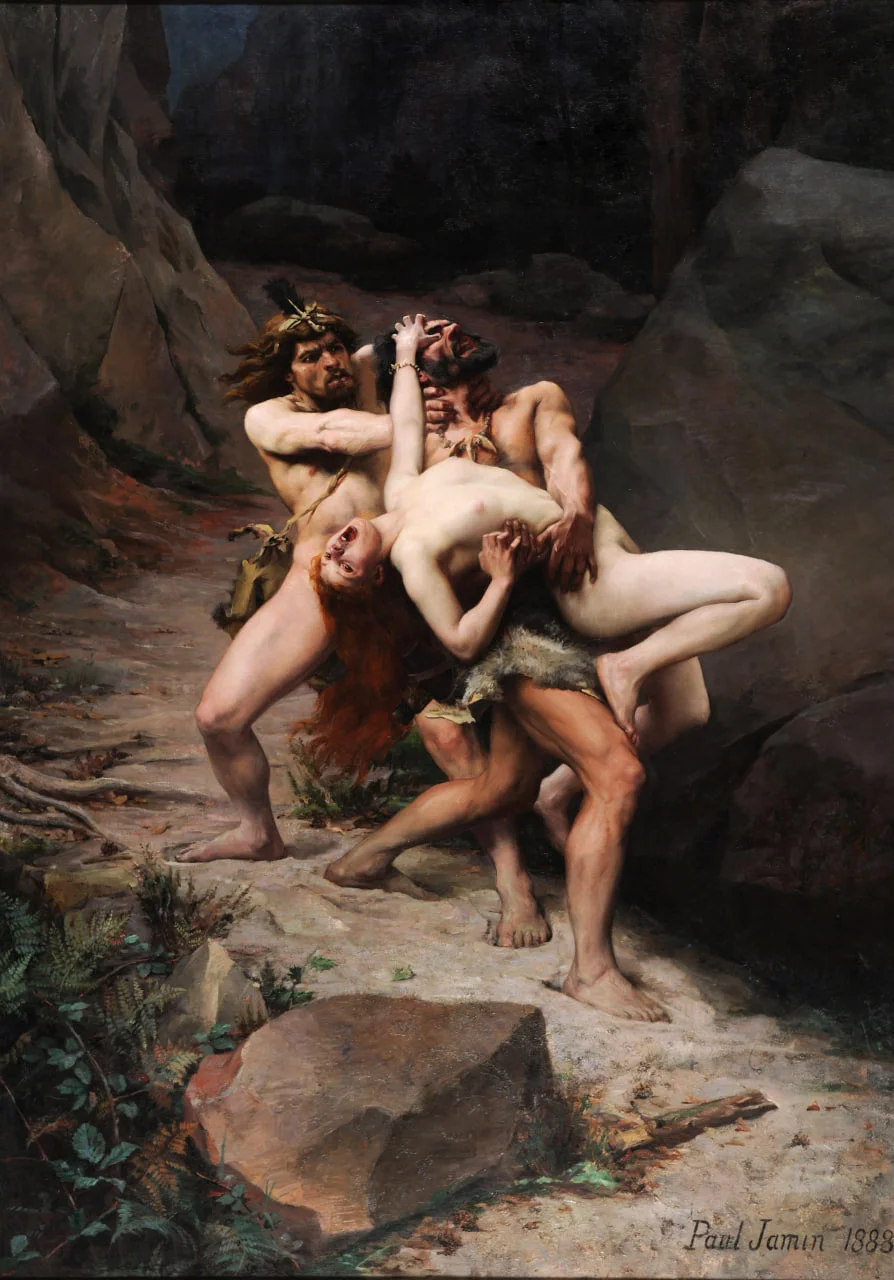
Paul Joseph Jamin (1853-1903). The Rape in the Stone Age. 1888. Found in the collection of the Musée des Beaux-arts, Rouen/Photo by Fine Art Images/Heritage Images via Getty Images
Selection favored females who could choose, seduce, and strongly bond with the most caring, reliable, and strong male, capable of providing the maximum protection and material support for both the female and her offspring. Selection also favored males who could maximize the survival of their own offspring and those whom females were less inclined to cheat on (there must have been selection for males who could deeply win the love of females). Selection likely also favored males who, despite being married, managed to have affairs and leave many illegitimate children, leaving their care to the deceived husbands. There must have been selection for males capable of preventing their wives' infidelity, deterring and punishing the seducers of other men's wives. Emotions such as jealousy could well be evolutionary adaptations that developed to combat infidelity (though jealousy, in a broader sense—as an emotion motivating competition for mates—is widespread among many primates).
Additionally, selection likely favored wives who, when the opportunity arose, could still cheat on their caring husbands, with males exceptionally skilled at seducing other men's wives, thereby leaving more illegitimate children. If a female managed to bear sons from such a "macho" male, the sons would inherit his abilities, giving the female more grandchildren. As a result, her genes, which promote secret infidelity with skilled seducers, would spread within the population.
Sophisticated tricks, intrigues, manipulations, surging passions, and complex tangled webs of relationships—these are what the tradition of monogamous families likely introduced into the lives of hominids.
What does an individual need to increase their reproductive success in such an environment? Brains, and once again, more brains.
Another (the third in our list) theory that explains the self-sustaining evolution of the brain and cognitive abilities in hominids is the idea of "a brain for intragroup cooperation." The self-sustaining evolution of cognitive abilities could have been driven not by competition between individuals within groups, as in the theory of Machiavellian intelligence, but by competition between groups themselves. In this case, abilities that allowed individuals to cooperate, negotiate, carry out complex coordinated actions for the benefit of the group, and remain loyal to their group would have been prioritized. Such behavior also requires strong cognitive abilities, and intense intergroup competition could give this process a self-sustaining character.
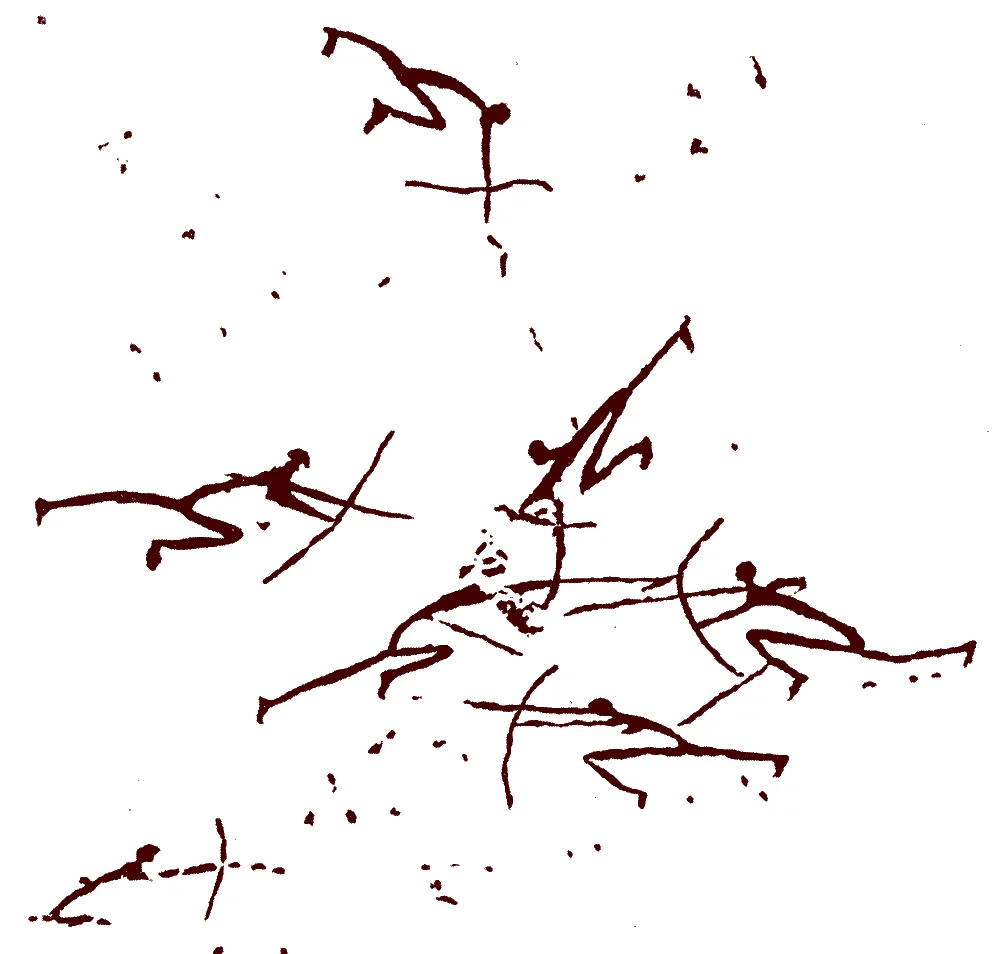
Cave painting of a battle between archers, Cueva del Roure, Morella la Vella, Castellón, Valencia, Spain/Wikimedia Commons
There is also another (the fourth in our list) theory, which unites all the previous ones and is considered by many experts today as the most promising and plausible. This is the theory of the self-sustaining coevolution of the brain and culture. This mechanism is also known as "cultural drive" or the "cultural brain hypothesis." We will discuss it in the next lecture.
